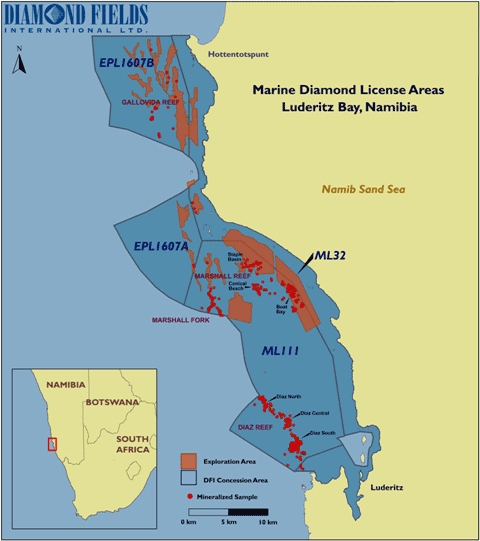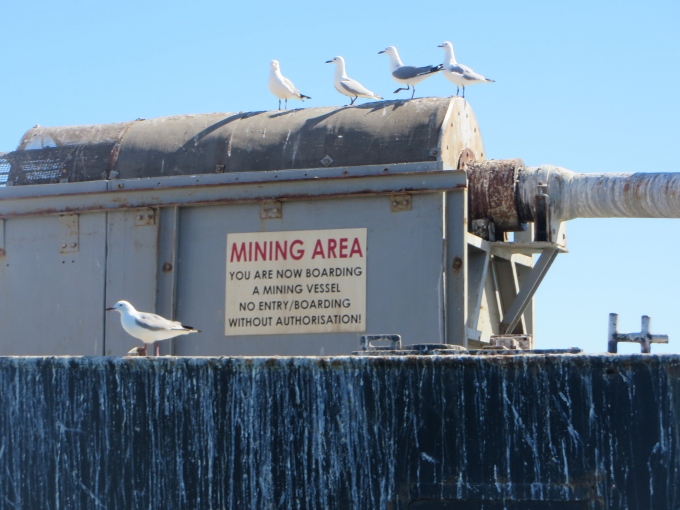Diamond Boats of Lüderitz
/As we motored into Lüderitz harbor a few weeks ago, we noticed fishing boats with long tubes/hoses extending into the water off their sterns. We'd never seen anything like this before and we wondered what they were. The answer? They're used for sucking up diamonds from the seabed.

Obviously, with all the restricted “Sperrgebiet” areas offshore, we expected to see the diamond mining boats, but we weren't sure exactly what they'd look like. I guess we expected really high-tech, not fishing boats with vacuum hoses. Talking with some folks in the industry, there are, indeed, some very large, high-tech recovery ships out there, but for the most part, here in Lüderitz, the diamond-mining fleet are converted fishing vessels. They go out for 3-4 weeks at a time, suck up potentially-rich alluvial sand and then offload it at the local Namdeb (Namibia-DeBeers Diamond Corporation) Contractor Treatment Facility (CTF) processing plant for sifting and sorting.
The boats are privately owned and the owners work as contractors for Namdeb, sampling and mining the shallow waters between Oranjemund to the south and Luderitz. The specially outfitted fishing vessels are each given a certain section to explore and mine. The boats are used as mining platforms. It's up to the owners to conduct diver-assisted exploration, figure out what areas have most potential and do all the work.
According to Diamond Fields Intl, “all diamonds are created deep in the earth's crust at very high temperatures and under incredibly high pressure. As magma works its way to the surface through deep fractures it sometimes traps diamonds within it. The magma is very low in silica and after it erupts and cools, it forms Kimberlite or lamprolite rocks. The pipe or dyke represents the conduit that brought the diamonds to the surface. Kimberlite pipes are only found in ... areas of rock that are at least 2.5 billion years old. The first kimberlite pipe was discovered near the town of Kimberly, South Africa, hence the name. Over the past 90 million years, research has shown that most of the drainage basins in the area have flowed from east to west and emptied into the Atlantic Ocean. This means that weathering, mostly from rain, has eroded diamonds out of kimberlite pipes and swept them into river systems. The diamonds were then carried out onto the delta system where the river meets the ocean. Initially, the diamonds were concentrated in small tidal channels on the river delta and in beaches near the delta. Constant wave and current action, however, later redistributed them up along the coast of Namibia.” How fortunate for the Namibians … and Namdeb.
In June 2002, the largest diamond, a 17.4 carat gem quality diamond, was recovered from the Lüderitz offshore concession by the mining vessel mv Namakwa. It was the largest diamond ever recovered by marine mining in the area. Marine diamonds are harder than their earth-mined counterparts and as many as 95% of the diamonds mined in this area are gem quality.
Though we could get close enough to the boats to take pictures, security is very tight. Locals tell us that the entire harbor and bay are under constant camera surveillance.
A sidebar ... Namdeb's motto is “On diamonds we build”. The DeBeers Group, the world's leading diamond company was founded in 1888 by Cecil Rhodes (think Rhodes Scholar) and is a 50% partner, along with the Namibian government, of Namdeb. DeBeers' famous slogan “A diamond is forever” has appeared in every De Beers engagement advertisement since 1948. In 1999, Advertising Age proclaimed it the slogan of the century!
Is it really August already? Rabbits, rabbits, rabbits. We've been here in Luderitz a month now. Where has the time gone?







